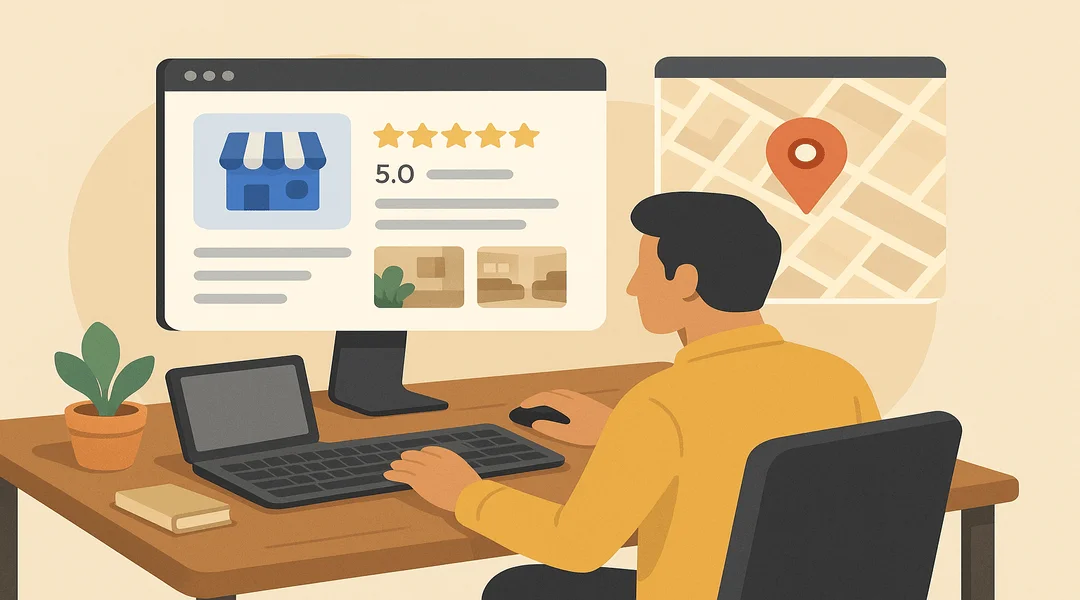Running a restaurant today means competing for attention long before anyone walks through the door. Truth is, even the best recipes fall flat if customers never discover them online.
With more than 80% of diners searching the internet before deciding where to eat, a weak digital presence puts restaurants at risk of fading from view. That slow disappearance happens quietly, often without owners realizing it until foot traffic and reservations start slipping.
So the smarter move is to build a strong search foundation that keeps your tables full and your brand top of mind. Let’s take this step by step, starting with what matters most for visibility.
Optimize Your Google Business Profile First
- Start with accurate business information across every platform. Matching details help Google trust your listing and reward it with better local placement.
- Add high-quality photos of dishes, the dining room, and staff to increase clicks and foot traffic. People make emotional decisions fast when visuals trigger appetite.
- Publish updates through Google Posts, including events, special menus, or service changes.
- Integrate SEO strategies for restaurants into your Google Business Profile updates so local diners see relevant search cues that help them pick you over nearby competition.
- Focus on structured service options, reservations, parking info, and delivery links to capture intent from hungry customers who search on the go.
Keeping this listing fresh signals activity, accuracy, and reliability at a time when customers abandon outdated profiles instantly. Restaurants that treat GBP like a digital storefront often earn higher discovery rates and conversions.
Focus on Local Keyword Targeting Strategies
Local search can make or break your visibility because diners rarely browse beyond a few top results when hunger hits. Getting inside those searches requires a deliberate keyword strategy that reflects how real people speak and what they crave. You’d be surprised how often restaurants miss out simply because their content doesn’t match local phrasing.
Google’s own data shows that half of customers who perform a local mobile search visit a business within one day, so aligning your keywords with neighborhood language is non-negotiable. Think about diners searching for “vegan brunch near me” or “best pizza Downtown.” When your site uses the same phrasing, you meet customers at the exact moment they’re choosing where to go.
This kind of alignment improves rankings, boosts organic traffic, and ensures your pages appear when diners compare similar options nearby. Supporting these patterns with mentions of local events or landmarks works even better because people tend to search around the things they recognize most.
Leverage Customer Reviews for Visibility Boosts
- Encourage guests to leave reviews after dining because positive feedback influences both credibility and ranking signals.
- Respond regularly to comments across platforms like Google, Yelp, and Facebook to show active engagement.
- Use consistent information in every response so algorithms trust your business accuracy.
- Add subtle references to SEO for restaurants in replies when appropriate to reinforce keyword relevance.
- Highlight menu updates, dietary options, or service features when responding to feedback to guide new searchers naturally.
People trust restaurants that acknowledge customers publicly. It feels personal and sincere. And since search engines evaluate both review volume and interaction quality, staying active here gives your restaurant a meaningful competitive edge.
Create Mouthwatering Menu Pages with Schema
Menu pages are where interest turns into action. And let’s be honest, people want a preview before committing. Schema markup gives search engines deeper context about your dishes, improving how they appear in search results. That clarity helps diners compare options quickly without bouncing between multiple sites.
Structured data also supports pricing visibility, which increases clicks and encourages decision-making before arrival. Adding dietary tags in both text and code appeals to the growing number of guests with allergies or lifestyle preferences. When your menu feels accessible and transparent, dwell time increases, and conversions follow.
Keeping these pages updated with seasonal images, trending dishes, or new pairings makes your restaurant feel alive. Search engines respond to that freshness, and diners reward it with bookings.
Maximize Mobile Experience to Attract Diners
- Ensure your website loads fast on mobile. Slow pages drive away even the most loyal regulars.
- Use click-to-call buttons prominently for quick reservations or inquiries.
- Make sure menus are easy to scroll, zoom, and read without pinching.
- Integrate mobile ordering and mobile payments to reduce friction for guests who prefer speed.
- Include secure pathways for checkout or deposits for special events.
Mobile is everything now. Around 70% of restaurant-related searches happen during peak meal times, and diners won’t tolerate websites that feel clunky or outdated. Responsive design, intuitive navigation, and modern payment options turn your digital experience into an accelerator for guest loyalty. Restaurants with a refined mobile experience tend to earn more repeat visits because convenience is part of today’s dining culture.
Utilize High Quality Food Photography Online
Restaurants risk fading from online view without high-quality food photography, which is a critical force behind consumer decision-making and digital visibility.
- Website Visitation Rises with Visuals: 77% of consumers visit a restaurant’s website before ordering online, according to survey data sourced by The New York Times. Plates photographed with care grab attention, keep visitors on your site longer, and influence their choice in seconds.
- Social Media Engagement Soars: 82% of American restaurants use social media marketing, yet only those sharing captivating food photos see regular interaction (Playpod blog). Dull or missing images leave you overlooked while vivid visuals drive shares and save-to-visit actions that boost real-life sales potential.
- Outdoor Displays Drive Curiosity: Large exterior photographs can turn awkward patios or alleyway dining into engaging environments customers want to share (as seen throughout Florida). These prints add character outdoors all year round; they spark conversation, which translates into organic local exposure both in person and online.
- Skill Development Pays Off Online and Onsite: Investing time to improve your food photography pays off across platforms, from websites to physical outdoor spaces, and brings long-term growth opportunities described by respected photographers like Andrew Scrivani in his books on the craft.
Update Opening Hours and Special Events Regularly
Running a restaurant means things change constantly. Hours shift. Menus rotate. Events appear and disappear. But online, customers expect perfect accuracy. Even small errors can cause customers to skip calling or showing up, which hurts business more than most owners realize.
Regular updates through Google Posts or your website show your restaurant is active and attentive. These signals also influence search engines, which want to recommend listings that feel current. Outdated pages, last year’s holiday hours, or forgotten event announcements look neglected and push diners toward better-maintained competitors.
SEO Vendor’s tools help automate these updates so agencies managing multiple restaurants stay aligned across platforms. This ensures accuracy without manual repetition, keeping listings sharp and trustworthy.
Expand Local Visibility Through Community Engagement
- Share posts connected to seasonal events, festivals, or neighborhood news to attract local searchers.
- Highlight your participation in charity events or community programs to strengthen trust signals.
- Publish content that references nearby streets, buildings, or public spaces for hyperlocal SEO.
- Encourage user-generated content from loyal customers, especially photos from unique angles or special moments.
- Create small campaigns tied to local influencers or micro-creators who share authentic experiences.
Community engagement strengthens your visibility because it creates signals across channels that diners recognize. When customers search for dining options during popular events or near specific landmarks, your restaurant gains higher relevance. These patterns compound over time, improving your authority in local search.
Build a Scalable SEO Framework for Restaurants
SEO gains become stronger when restaurants follow a consistent framework that scales across multiple pages and platforms. Agencies that manage restaurant clients need predictable workflows that reduce time, avoid guesswork, and produce measurable outcomes. That is where SEO Vendor supports growth.
Our tools provide guiding workflows that help agencies integrate structured keyword research, local optimization tips, and content templates that reflect industry best practices. This matters because restaurants operate in fast-changing environments where promotions, menus, and events update frequently.
By using standardized SEO roadmaps and transparent optimization steps, agencies build trust with restaurant clients. Clear inputs, clear actions, and clear outcomes give everyone confidence that strategies are paying off.
Support Long-Term Visibility Through Structured Content
Restaurant SEO works best when content depth grows year after year. Topical authority matters here. Covering relevant themes like cuisine styles, local food trends, preparation methods, or chef stories creates a body of work that signals expertise to search engines.
Building this structure helps restaurants earn more organic positions, appear in rich snippets, and increase dwell time. It also gives agencies flexibility to refresh, repurpose, or expand content without reinventing the strategy each season.
When restaurants publish consistently, they earn more organic traffic and become part of the local dining conversation online instead of being overlooked.
Stay Visible Before Customers Look Away
Ignoring SEO puts restaurants at serious risk of disappearing in a crowded digital landscape. Even the best chefs lose visibility if search engines cannot understand or rank their content. More than 90% of diners check menus or reviews before going anywhere. That is why agencies must guide restaurant clients with structured strategies that improve visibility, increase reservations, and sustain foot traffic.
At SEO Vendor, we help agencies scale their efforts with transparent tools and proven processes. From white label optimization workflows to reliable SEO mapping and automated updates, our platform strengthens the connection between restaurants and the customers searching for them. When diners look for their next great meal, your clients deserve to be the first name they see.









